Demystifying the Technology Behind Our Digital World
Hello fellow tech enthusiasts and cloud explorers!
Have you ever wondered what happens when you back up your photos, stream your favorite shows, or access your work documents from anywhere? Behind these everyday digital conveniences lies a revolutionary technology that powers our connected world: cloud computing. Today, I’m excited to take you on a comprehensive journey through this transformative technology that’s reshaping how businesses operate and how we interact with digital services.
What Exactly Is Cloud Computing? ☁️
At its core, cloud computing is the delivery of computing services—including servers, storage, databases, networking, software, analytics, and intelligence—over the internet (“the cloud”) to offer faster innovation, flexible resources, and economies of scale.
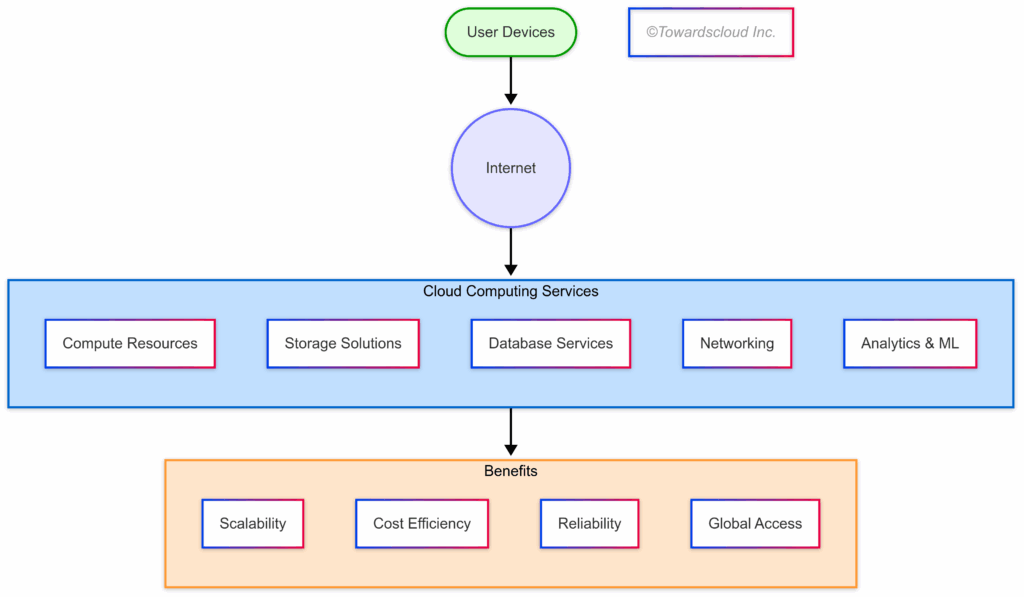
Instead of maintaining all your computing resources (the hardware, software, and data storage) on-site, cloud computing lets you access these resources via the internet, on-demand, wherever and whenever you need them. This fundamentally changes the economics and agility of IT by shifting from a capital expenditure model to an operational expenditure approach.
Why Cloud Computing Has Become Essential 🚀
Cloud computing isn’t just a technological shift—it’s a business transformation enabler. Here’s why organizations worldwide are embracing it:
1. Unparalleled Flexibility and Scalability
One of the most compelling advantages of cloud computing is its elasticity. Need to handle a sudden spike in website traffic? Want to analyze terabytes of data for a one-time project? Cloud resources can scale up or down almost instantly to match your needs.
For startups and enterprises alike, this means you can:
- Launch new services without massive infrastructure investments
- Adapt to changing market conditions rapidly
- Test new ideas with minimal financial risk
- Scale computing resources in real-time based on actual demand
2. Significant Cost Optimization

Traditional IT infrastructure requires substantial upfront capital investment in hardware that depreciates over time and needs periodic replacement. The cloud transforms this model fundamentally:
- Pay only for the resources you actually use
- Eliminate hardware maintenance and upgrade costs
- Reduce physical data center expenses (power, cooling, space)
- Minimize IT staffing requirements for infrastructure management
According to research, organizations typically see 20-30% cost savings when migrating appropriate workloads to the cloud.
3. Global Accessibility and Collaboration
The cloud breaks down geographical barriers:
- Access your applications and data from anywhere with internet connectivity
- Enable remote work and distributed teams
- Collaborate on documents and projects in real-time
- Deploy regional resources to serve global customers with minimal latency
4. Enhanced Security and Disaster Recovery
Contrary to early concerns, major cloud providers now offer security capabilities far beyond what most organizations can implement themselves:
- State-of-the-art physical security at data centers
- Advanced encryption and identity management
- Continuous security monitoring and threat intelligence
- Automatic security patching and updates
For disaster recovery, cloud platforms provide:
- Automated backup solutions
- Geo-redundant storage options
- Rapid recovery capabilities
- Simplified business continuity planning
Cloud Service Models: The “aaS” Family 🧩
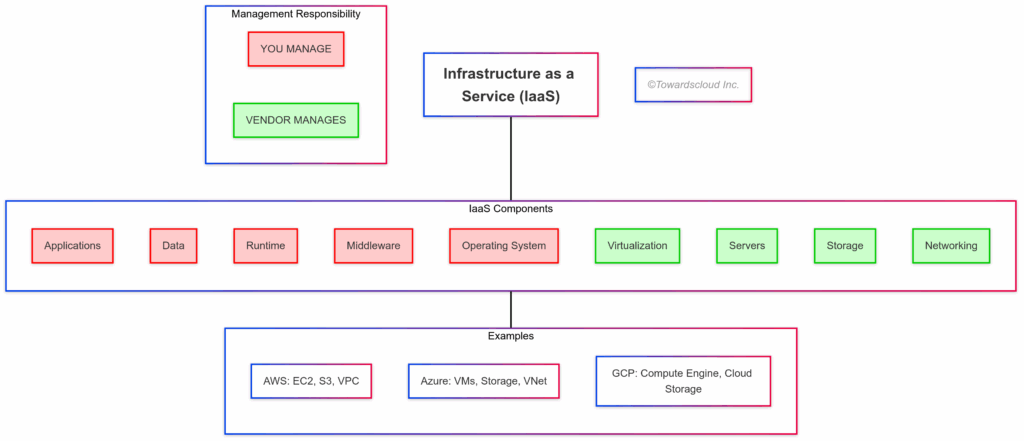
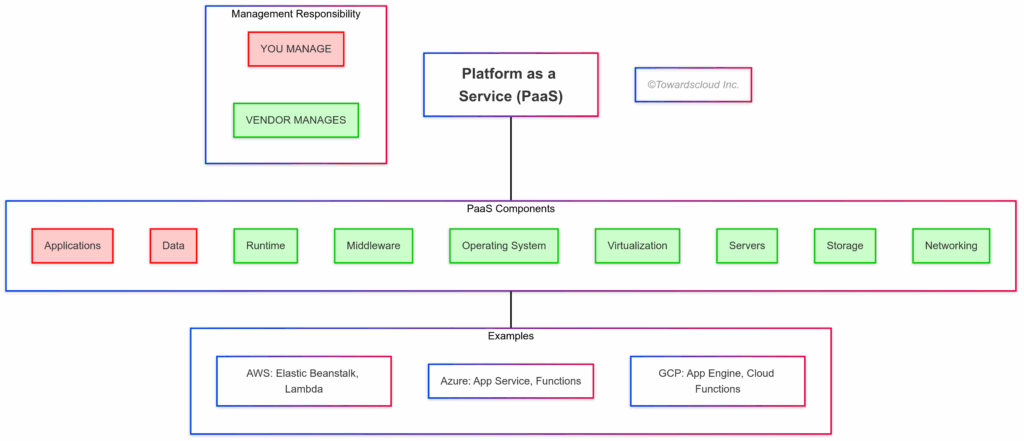
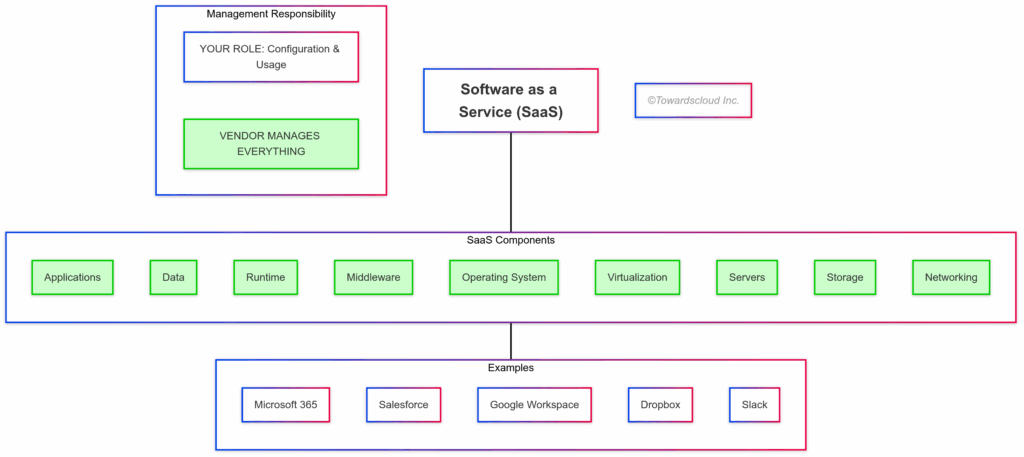
The cloud service model spectrum describes different levels of management responsibility between you and your cloud provider. Let’s examine each model in detail:
1. Infrastructure as a Service (IaaS)
IaaS provides the fundamental building blocks of cloud IT: virtualized compute, storage, and networking resources.
Key characteristics:
- You manage: Applications, data, runtime environment, middleware, operating systems
- Provider manages: Servers, storage, networking, virtualization, data centers
- Users: System administrators, IT operations
Real-world examples:
- AWS: Amazon EC2, EBS, VPC
- Azure: Virtual Machines, Virtual Networks
- GCP: Compute Engine, Cloud Storage
Best for: Organizations that want maximum control over their infrastructure without managing physical hardware.
2. Platform as a Service (PaaS)
PaaS takes abstraction a step further by providing a complete development and deployment environment in the cloud.
Key characteristics:
- You manage: Applications and data
- Provider manages: Runtime, middleware, OS, virtualization, servers, storage, networking
- Users: Developers, testers, DevOps teams
Real-world examples:
- AWS: Elastic Beanstalk, Lambda
- Azure: App Service, Functions
- GCP: App Engine, Cloud Functions
Best for: Development teams that want to focus on coding and testing without infrastructure distractions.
3. Software as a Service (SaaS)
SaaS delivers fully functional applications over the internet, eliminating all management responsibilities except configuration.
Key characteristics:
- You manage: Basic application configuration, user access
- Provider manages: Everything else, including the application itself
- Users: End users across all departments
Real-world examples:
- Microsoft 365 (formerly Office 365)
- Salesforce CRM
- Dropbox
- Slack
Best for: Organizations looking for ready-to-use applications with minimal IT overhead.
Cloud Deployment Models: Finding Your Perfect Match 🏢
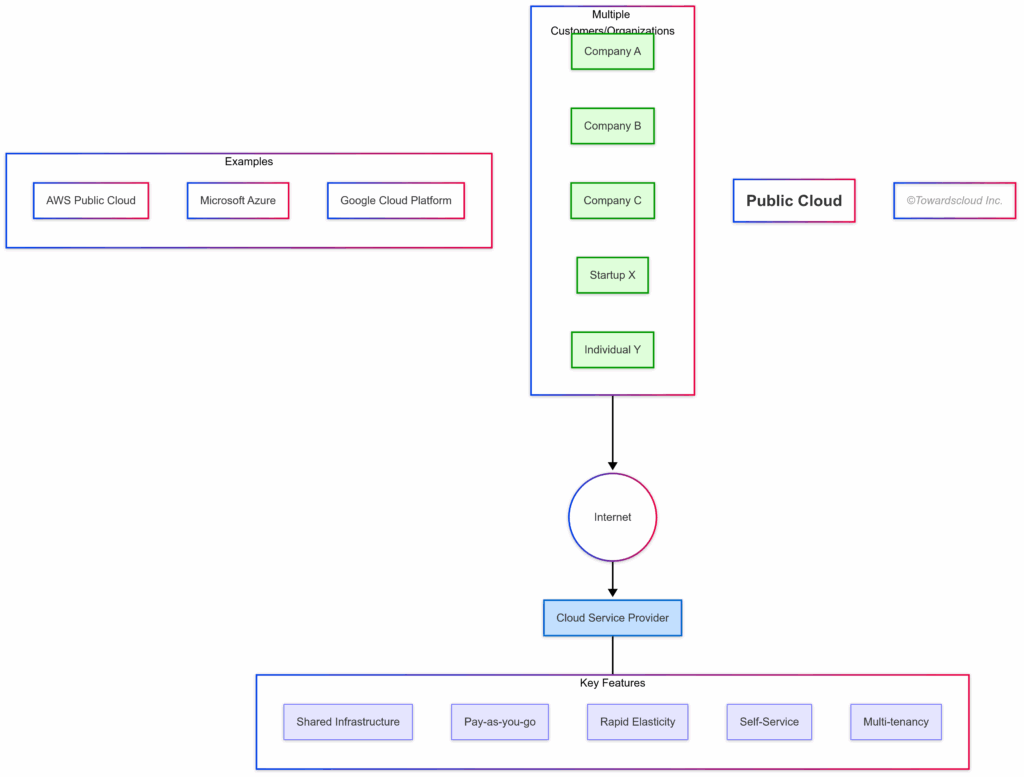
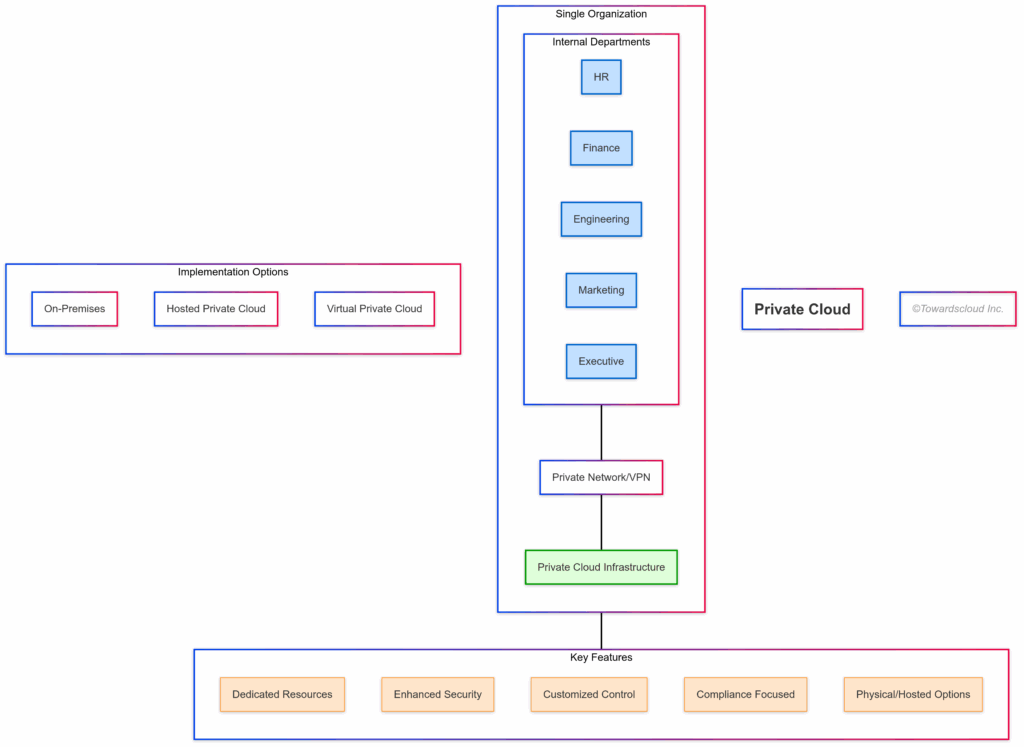
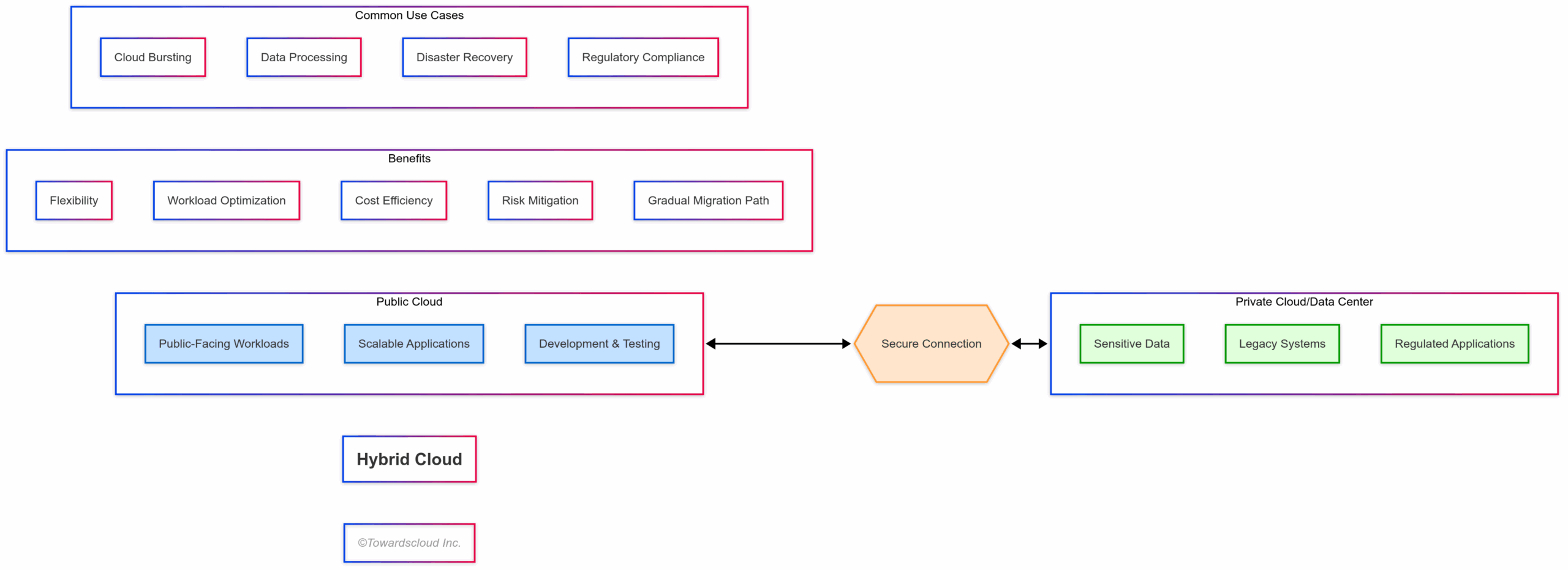

The cloud deployment model you choose determines where your cloud resources reside and who manages them. Each model offers different trade-offs between cost, control, scalability, and security.
1. Public Cloud
Public cloud involves leveraging shared infrastructure operated by third-party providers over the public internet.
Key characteristics:
- Resources are owned and operated by third-party cloud providers
- Delivered over the internet
- Multi-tenant environment (shared infrastructure)
- Self-service management
- Pay-per-use pricing model
Benefits:
- Unlimited scalability
- Lower costs (no capital expenditure)
- Reduced maintenance
- High reliability
- Geographical distribution
Challenges:
- Less control over infrastructure
- Potential security and compliance concerns
- May face performance limitations
- Possible vendor lock-in
Ideal for: Organizations seeking cost-efficiency and scalability with minimal infrastructure management.
2. Private Cloud
Private cloud provides cloud-like services on dedicated infrastructure, either on-premises or hosted by a third party.
Key characteristics:
- Dedicated exclusively to a single organization
- Located on-premises or in a service provider’s data center
- Maintained on a private network
- Proprietary architecture
Benefits:
- Enhanced security and privacy
- Greater control over infrastructure
- Customization options
- Easier compliance with regulatory requirements
- Consistent performance
Challenges:
- Higher costs (capital expenditure)
- Limited scalability
- Requires specialized expertise
- Responsibility for maintenance and updates
Ideal for: Organizations with stringent security, regulatory, or performance requirements.
3. Hybrid Cloud
Hybrid cloud integrates public and private clouds, allowing workloads to move between environments based on needs.
Key characteristics:
- Combination of public and private clouds
- Interconnected but distinct environments
- Orchestration between platforms
- Workload portability
Benefits:
- Flexibility to run workloads in optimal environments
- Cost optimization (run non-sensitive workloads in public cloud)
- Gradual cloud migration path
- Risk mitigation through diversification
- Scalability with security
Challenges:
- Complexity in management and integration
- Potential security gaps between environments
- Requires sophisticated networking
- Monitoring across diverse environments
Ideal for: Organizations that need both the security of private cloud and the scalability of public cloud.
4. Multi-Cloud
Multi-cloud involves using services from multiple cloud providers to avoid vendor lock-in and leverage unique capabilities.
Key characteristics:
- Utilizes multiple cloud providers (e.g., AWS, Azure, GCP)
- Selective service consumption
- Independent management of each cloud environment
- Strategic service distribution
Benefits:
- Avoiding vendor lock-in
- Leveraging best-of-breed services
- Geographic distribution
- Negotiation leverage with providers
- Reduced outage risk
Challenges:
- Increased management complexity
- Integration challenges
- Skills diversification requirements
- Security standardization
Ideal for: Organizations seeking provider redundancy or unique services from different vendors.
The Cloud Computing Landscape: Major Providers 🏆
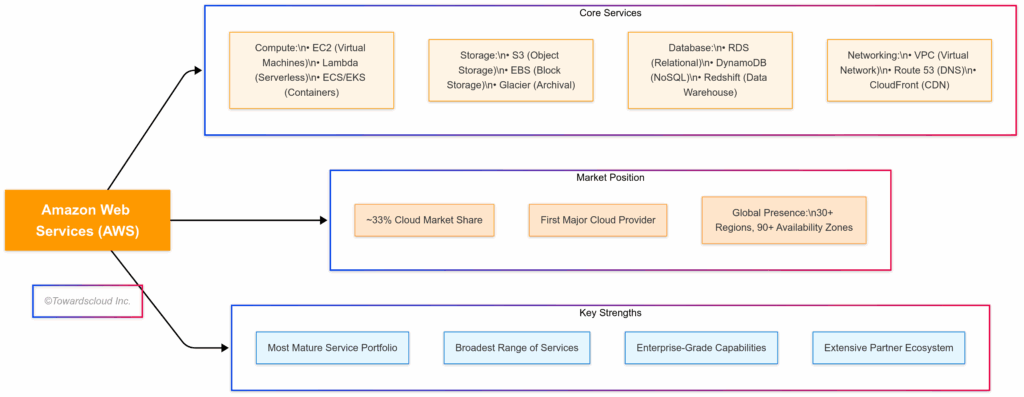
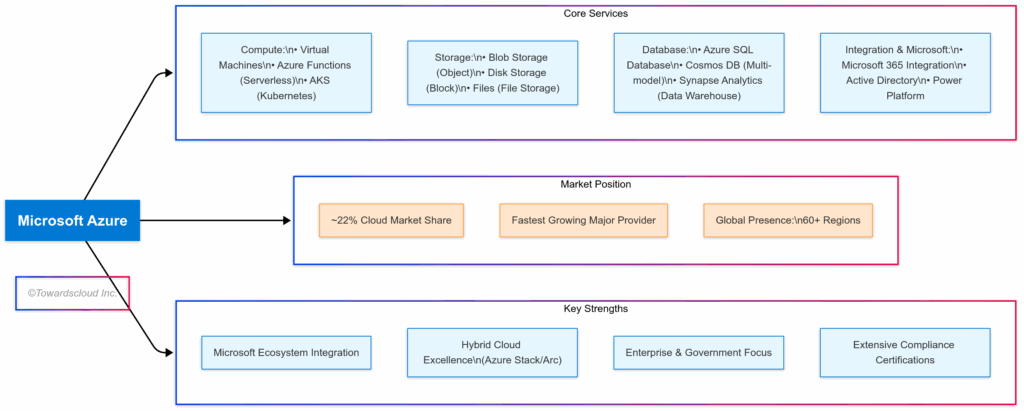
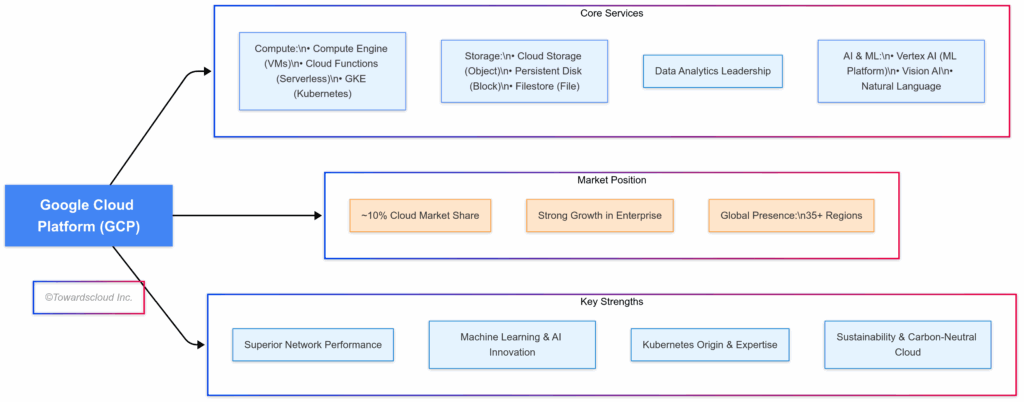
The cloud services market is dominated by several major providers, each with unique strengths, pricing models, and service offerings. Let’s examine the “big three” cloud providers in detail:
Amazon Web Services (AWS)
As the pioneer in cloud computing and current market leader, AWS offers the broadest range of services.
Key strengths:
- Most mature and comprehensive service portfolio
- Largest global infrastructure footprint
- Deep ecosystem of partners and third-party integrations
- Advanced enterprise-grade features
- Extensive documentation and community support
Notable services:
- Compute: EC2 (virtual machines), Lambda (serverless)
- Storage: S3 (object storage), EBS (block storage)
- Database: RDS (relational), DynamoDB (NoSQL)
- Networking: VPC, Direct Connect, Route 53
Ideal for: Organizations needing the widest range of services, global reach, and enterprise-ready features.
Microsoft Azure
Microsoft’s cloud platform excels at integrating with existing Microsoft technologies and supporting hybrid cloud scenarios.
Key strengths:
- Seamless integration with Microsoft products (Windows, Office 365, etc.)
- Strong hybrid cloud capabilities (Azure Stack)
- Enterprise-friendly licensing and support
- Extensive compliance certifications
- Integrated identity management with Active Directory
Notable services:
- Compute: Virtual Machines, Azure Functions
- Storage: Blob Storage, Disk Storage
- Database: Azure SQL Database, Cosmos DB
- Integration: Logic Apps, Service Bus
Ideal for: Organizations with significant Microsoft investments, enterprises requiring hybrid solutions, and Windows-centric workloads.
Google Cloud Platform (GCP)
Google’s cloud offering emphasizes networking, data analytics, and machine learning capabilities.
Key strengths:
- Superior network performance and global infrastructure
- Advanced data analytics and machine learning capabilities
- Strong containerization technologies (Kubernetes originated at Google)
- Competitive pricing with innovative discount models
- Commitment to open source technologies
Notable services:
- Compute: Compute Engine, Cloud Functions
- Storage: Cloud Storage, Persistent Disk
- Data Analytics: BigQuery, Dataflow
- AI/ML: Vertex AI, AutoML
Ideal for: Organizations focused on data analytics, machine learning, and containerized applications.
Comparing Cloud Providers
When selecting a cloud provider, consider these factors:
- Service compatibility: Which platform best supports your existing workloads?
- Technical requirements: Which provider offers the specific services you need?
- Pricing structure: How do the cost models align with your usage patterns?
- Geographic presence: Does the provider have data centers in your target regions?
- Compliance and security: Which platform best meets your regulatory requirements?
Many organizations are adopting a multi-cloud strategy, using different providers for specific workloads based on their strengths.
Common Cloud Misconceptions 🧠

Despite its widespread adoption, several misconceptions about cloud computing persist:
1. “Cloud Means My Data Is Floating Around Unsecured”
Reality: Cloud providers invest billions in physical and digital security measures that far exceed what most organizations could implement independently. Data is stored in highly secure data centers with multiple layers of protection, including physical security, encryption, access controls, and continuous monitoring.
2. “Cloud Is Only for Big Enterprises”
Reality: Cloud computing scales to organizations of all sizes. Small businesses and startups often benefit the most from cloud adoption since it eliminates large capital expenditures and provides enterprise-grade capabilities with pay-as-you-go pricing.
3. “Moving to the Cloud Means Giving Up Control”
Reality: Cloud adoption is not all-or-nothing. Organizations can choose which workloads to migrate, which deployment models to use, and how much management responsibility to retain. The range of service models (IaaS, PaaS, SaaS) offers different levels of control.
4. “Cloud Computing Is Just a Passing Trend”
Reality: Cloud computing represents a fundamental shift in how computing resources are delivered and consumed. It’s now the dominant model for new application development and infrastructure deployment, with continued growth projected for years to come.
Final Thoughts: Embracing the Cloud Journey 🚀
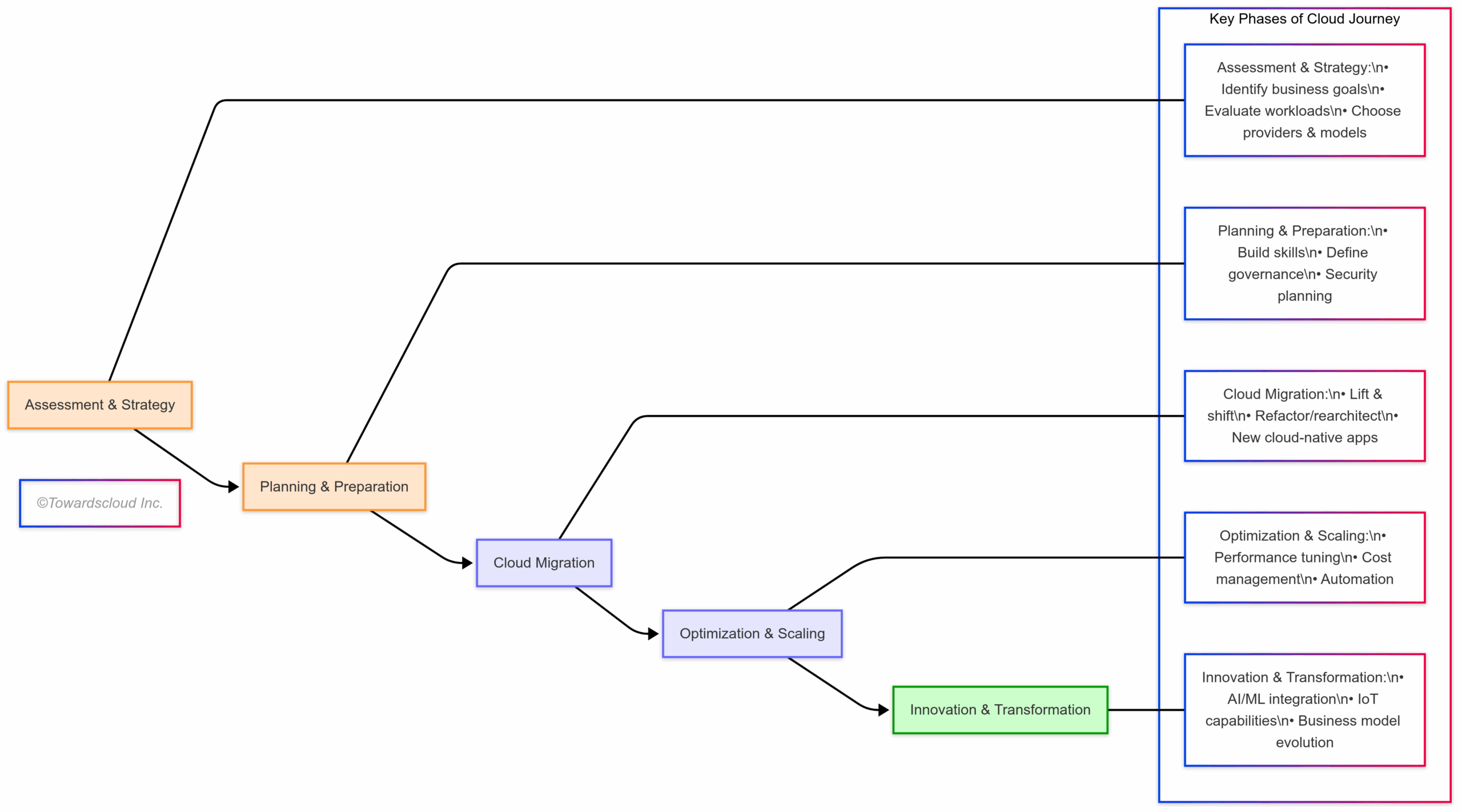
Cloud computing has evolved from a cutting-edge technology to the foundation of modern digital infrastructure. Its ability to provide scalable, flexible, and cost-effective computing resources has transformed how organizations build and deploy applications, store and analyze data, and deliver services to customers.
As we look to the future, the cloud will continue to evolve with advancements in areas like edge computing, serverless architectures, artificial intelligence, and quantum computing. Organizations that embrace cloud technologies position themselves to innovate faster, respond more effectively to changing market conditions, and focus their resources on creating business value rather than managing infrastructure.
Whether you’re just beginning your cloud journey or looking to optimize an existing implementation, understanding the fundamental concepts, service models, and deployment options is essential to making informed decisions that align with your organization’s needs and objectives.
What’s Next? 📝
In our next blog post, we’ll dive deeper into the “History and Evolution of Cloud Services” – exploring how cloud computing emerged from mainframes and client-server architectures to become the dominant computing paradigm of our era. We’ll trace the key milestones, technological breakthroughs, and market shifts that have shaped today’s cloud landscape.
Until then, we encourage you to explore the cloud concepts we’ve covered today and consider how they might apply to your specific technology needs and business goals.
Do you have questions about cloud computing fundamentals? Curious about specific cloud services or providers? Drop a comment below, and let’s continue the conversation!
Remember, the journey to the cloud isn’t about following trends – it’s about finding the right technology approach to drive your business forward in an increasingly digital world.